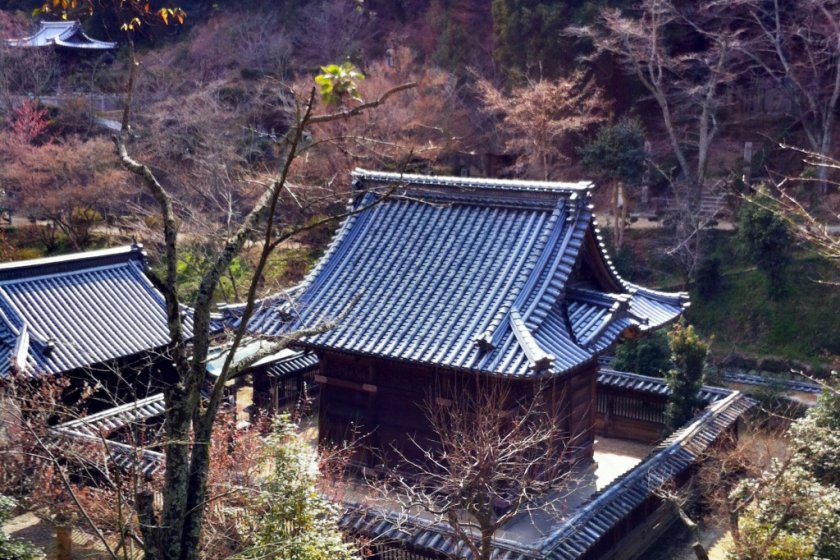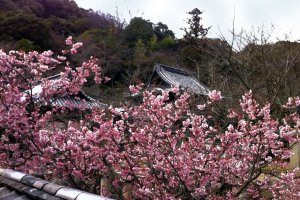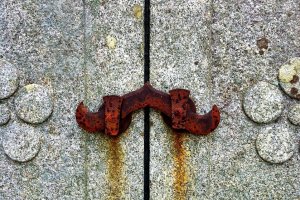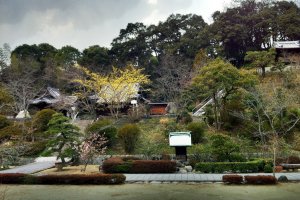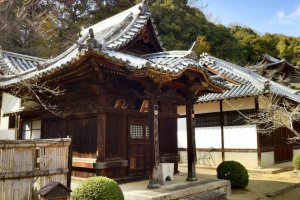The Joshin-ji Temple of the Tendai Buddhist sect stands in a narrow valley that leads up from the north of Dogo, close to Matsuyama Shrine. A stone in the temple is inscribed with this haiku;
Colors of birds
with beautiful feathers brimming over
a swarm of scarlet maple leaves
The temple was built by Sadayuki Matsudaira, the first feudal lord of the domain of Matsuyama, and the temple is the site of his mausoleum. More about this anon.
Joshin-ji is in a remarkably secluded place, up a narrow alley on the outskirts of Dogo. You could go to the slightly more obvious Matsuyama Shrine and miss Joshin-ji completely, which would be a shame because it’s a beautiful place. You arrive at the temple if you follow the road around to the right of the shrine. Even from in front of the gate, you get the impression of a small and insignifcant temple. But if you climb the steps and go inside the gate, all sorts of buildings come into view, with graveyards stretching all the way into the richly wooded hills behind.
Joshin-ji is a complex of temples, shrines and mausoleums on multiple levels, with many varieties of flowering trees. Camellias are the representative flower of Ehime and there are lots of them in red and pink. If you go in spring, the many types of cherry will also be in bloom. The maples mentioned in the haiku are also dotted around, and their pretty young leaves appear in early April and turn a vivid red in October.
At the entrance to the temple, Matsuyama Board of Education has placed useful signs in English with the following explanations;
“Mausoleum of Matsudaira Sadamasa
Matsudaira Sadamasa was born in 1610. He served the third shogun, Tokugawa Iemitsu, and in 1649 became the lord of Kariya Domain in Mikawa Province (now Aichi Prefecture). After Iemitsu’s death, Sadamasa petitioned the Shogunate for political reform, offering to return his domain. The Shogunate, judging him to be mad, confiscated his territory and entrusted it to Sadamasa’s brother, Sadayuki. Matsudaira Sadamasa lived in seclusion in the Hatadera area of Matsuyama, enjoying the composition of waka poetry and flower arrangement until his death in 1673, at the age of 63.”
Sadamasa’s mausoleum is an exceedingly modest building. The mausoleum of his brother standing next to it is a good deal grander. Of him the Board of Ed. says,
“The style of construction is representative of mausolea built in the early Edo period (17th century). Matsudaira Sadayuki (1587 to 1668) was the son of Shogun Tokugawa Ieyasu’s half brother. He came from Kuwana in Ise Province (now Mie Prefecture) in 1635 to become lord of Matsuyama Domain. Sadayaki encouraged the planting of tea and paper mulberry, along with tea processing and paper manufacture and consolidated the domain’s economy.”
From the graveyards behind the mausoleums there are good views over the city to the mountains in the south. I didn't see any of the colorful birds, but the flora was beautiful.
